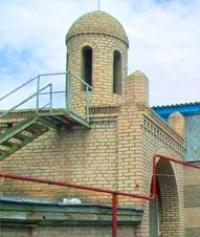You are here
Auliye-Ata Mosque. Yunus-bai mosque.

Bus and walking tour in Taraz.
“Ancient aphorisms outlived centuries. Modern aphorisms can barеly survive from book to book”
Ljupka Cvetanova.
Muslim monuments of Taraz.
Aulie-Ata Mosque - the beginning of the XXth century, an architectural monument is located along Elektricheskaya Street, 24 in town Taraz. The original name is the Yunus-bai mosque (kaz. Zhunis bai mechitі, transcription variants - Zhunus-bai and Zhunis-bai).
Included in the list of architectural monuments of republican significance in Kazakhstan. It is located in the old part of the city, near the historical core, at the intersection with Kylyshbai akyna street. It is located in the depths of a spacious courtyard, type "Juma-Mosque", typical for religious buildings of the Central Asian region.
The mosque was built in 1913 by the order of the merchant Yunuskhan, it was re-planned several times. The construction of the mosque was carried out at the expense of a local resident of Kali, Yunus Mayusulov, also known as Yunus-bai (other versions of the transcription are Zhunus-bai and Zhunis-bai).
The construction was supervised by the master Seydulla Kozha. The main stage of construction took place in 1904 - 1906 (according to other sources - in 1902 - 1906), but the opening took place only in 1913. In 1998, reconstruction was carried out, the mosque was expanded due to a new extension.
Only the building of 1913 is of artistic value. A one-storey rectangular in plan, an extended volume, with a ceiling raised high on columns, is divided into the southern and northern parts. The old prayer hall in the southern part (1913) is a spacious room about 21 meters long and up to 12 meters wide, in the center of the blank western wall there is a mihrab niche, the ends of the walls are cut through with high windows. During one of the repairs, the eastern wall was opened towards the aivan, from the outside it was completely glazed.
On both sides of the mihrab at a height of 20 meters, mezzanines are arranged across the entire width of the hall. The ceiling of the hall, made in a beam structure with a vass filling and painted with polychrome ornaments of geometric and plant motifs, is distinguished by a special artistic expressiveness.
Now the aivan is hidden by an extension of the entrance, crowned with a dome. The northern part (annex 1973) was a glazed aivan with numerous columns. In the first years of Soviet power, the mosque was closed and reopened several times.
After a period of mass famine in the early 1930s, a granary was organized in the mosque, later it was converted into a barracks. However, in 1943 the mosque was returned to the believers. During the Great Patriotic War, parishioners raised funds to buy a tank for the Red Army.
In 1973-1974, restoration work was carried out in the mosque. In 1982, the mosque was investigated by researchers of the Dzhambul Museum of History and Local Lore. In 1998 - 1999, a new restoration was carried out according to the project of the architect Nurlybek Baekeyev.
The name of the mosque after the restoration was changed to Aulie-Ata - in honor of the founder of the medieval dynasty of the Karakhanids and the first name of the town of Taraz. The Aulie-Ata mosque was considered the spiritual center of the Muslims of Taraz until 2007, when the Khibatulla Tarazi mosque was opened on April 27.
In addition to the mosque itself, the original complex of buildings also included a library, a bathhouse, a madrasah and an imam's office. The original dimensions of the mosque are 27 x 12 meters. Three walls are built of baked bricks, the eastern wall is made of wood.
The building's top floor is supported by 18 timber beams. At the entrance, an arched gate is arranged, continuing with two high steles. The one-story rectangular building volume is divided into southern and northern parts.
The main prayer hall is located in the southern part of the building. The interior walls and ceiling are painted with a floral pattern using paints from natural materials and framed with an ornament border. Mihrab is located in the western wall.
The interior of the mosque is decorated with ornamented wooden engravings. During the restoration of 1998 - 1999, the mosque was expanded with a new extension with an area of 9 x 26 meters. In addition, support beams were added, the courtyard was re-paved with stone slabs, and new doors were installed.
Authority:
"Guide to Taraz and the Zhambyl region." The publication of the Department of Tourism and Sports of the Zhambyl region.
Photos
Alexander Petrov.







